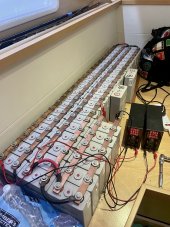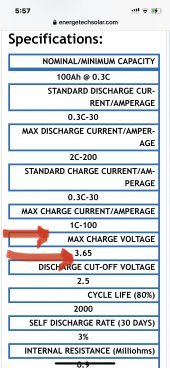TommyHolly
New Member
- Joined
- Jun 24, 2021
- Messages
- 207
Hello everyone,
I’m wondering if you can charge very discharged LiFePo4 cells at higher voltages to temporarily charge them faster.
I’m guessing the answer is no, but I’m mainly wondering why. It probably has something to do with gassing?
I just got finished capacity testing 48 CALB brand 3.2v 100Ah cells. While one cell was being tested for 4.5 hours at a 20A discharge rate, I always had the previous one tested charging with a variable voltage 10A charger at 3.65v.
I connected all 48 cells in parallel, and placed both variable volt 10A chargers on opposite ends. (See picture) However this is taking forever to charge. I’m guessing it’s going to be a week or longer!?
I noticed these chargers drop the current down the closer the cell is to reaching the target voltage of 3.65A. Eventually when it reaches 3.65v the Amps go to 0.000A.
Right now both chargers are about 6.8A each. (See pictures) I used a DC clip on Amp meter to test the amps going through and it’s indeed what the reading on the charger shows.
Each cell tested was brought down to 2.6v during the capacity test. A single charger takes about 11-12 hours to fully charge a cell back up to exactly 3.65v after that. *Remember, I was charging the previous cell for 4.5 hours, which means that the cell needs another 7-8 hours of charging with one single 10A charger.
So I’m guesstimating that each cell needs about 50Ah of charging to get back to 100% SOC.
50A x 48 cells = 2,400A
Divide my two 10A chargers (20A total charging)
2,400A needed divided by 20A = 120 hours
120 hours is at least 5 days of charging.
*Maybe it’s more because the 10A chargers only deliver the full 10A directly after the capacity test and the cell was completely drained. Right now they say 6.8A each. So really that’s only 13A of current charging.
2,400A divided by 13A = 185 hours of charging.
185 hours is almost 8 days of charging!!
Maybe my math is wrong and I’d be glad to know how to really figure it out.
But my main question is, could I temporarily raise the charging voltage to 5v or something to help speed this up without damaging anything? The maximum charging specs for the 3.2v 100Ah CALB cells
Is 3.65v (See pic of specs)
This is more of a theoretical question since I really don’t know what would happen and don’t plan on attempting it.
I’m wondering if you can charge very discharged LiFePo4 cells at higher voltages to temporarily charge them faster.
I’m guessing the answer is no, but I’m mainly wondering why. It probably has something to do with gassing?
I just got finished capacity testing 48 CALB brand 3.2v 100Ah cells. While one cell was being tested for 4.5 hours at a 20A discharge rate, I always had the previous one tested charging with a variable voltage 10A charger at 3.65v.
I connected all 48 cells in parallel, and placed both variable volt 10A chargers on opposite ends. (See picture) However this is taking forever to charge. I’m guessing it’s going to be a week or longer!?
I noticed these chargers drop the current down the closer the cell is to reaching the target voltage of 3.65A. Eventually when it reaches 3.65v the Amps go to 0.000A.
Right now both chargers are about 6.8A each. (See pictures) I used a DC clip on Amp meter to test the amps going through and it’s indeed what the reading on the charger shows.
Each cell tested was brought down to 2.6v during the capacity test. A single charger takes about 11-12 hours to fully charge a cell back up to exactly 3.65v after that. *Remember, I was charging the previous cell for 4.5 hours, which means that the cell needs another 7-8 hours of charging with one single 10A charger.
So I’m guesstimating that each cell needs about 50Ah of charging to get back to 100% SOC.
50A x 48 cells = 2,400A
Divide my two 10A chargers (20A total charging)
2,400A needed divided by 20A = 120 hours
120 hours is at least 5 days of charging.
*Maybe it’s more because the 10A chargers only deliver the full 10A directly after the capacity test and the cell was completely drained. Right now they say 6.8A each. So really that’s only 13A of current charging.
2,400A divided by 13A = 185 hours of charging.
185 hours is almost 8 days of charging!!
Maybe my math is wrong and I’d be glad to know how to really figure it out.
But my main question is, could I temporarily raise the charging voltage to 5v or something to help speed this up without damaging anything? The maximum charging specs for the 3.2v 100Ah CALB cells
Is 3.65v (See pic of specs)
This is more of a theoretical question since I really don’t know what would happen and don’t plan on attempting it.






